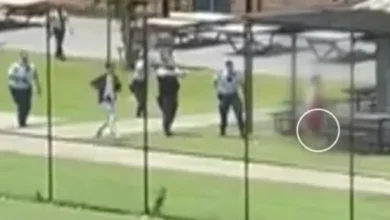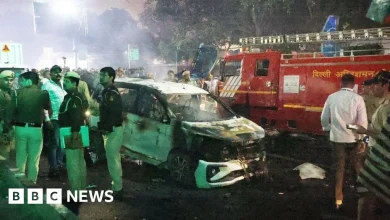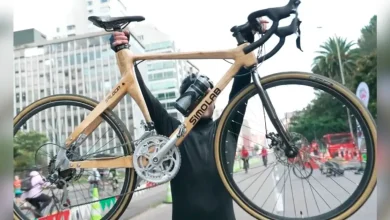Vegas qualifying mystery looms after latest chaos as Piastri left in the dark — F1 Talking Pts

What happens in Las Vegas stays in Las Vegas — except the manhole covers.
For the second time in three seasons, the Las Vegas Grand Prix has had a session disrupted by a loose manhole cover.
The first was of course FP1 in the race’s first running, in 2023. A loose water valve cover was sucked out of the ground and annihilated Caros Sainz’s Ferrari, costing him a chassis and a power unit. Esteban Ocon’s Alpine also sustained chassis damage.
Fox Sports, available on Kayo Sports, is the only place to watch every practice, qualifying session and race in the 2025 FIA Formula One World Championship™ LIVE in 4K. New to Kayo? Join now and get your first month for just $1.
That incident not only cost the sport pretty much all of FP1, but it triggered an hours-long delay before FP2 could start at the unhinged time of 2:30am, after every road fixture around the 6.2-kilometre street course was checked and resealed.
Last year the sport escaped without issue, but in 2025 a similar problem has recurred.
A manhole cover between Turn 16 and 17 appeared to work its way loose, although trackside marshals spotted the problem before it could break free entirely to destroy any cars.
The session was suspended for checks with around 20 minutes remaining. The track reopened with six minutes on the clock, but marshals spotted movement again when the cars thundered over the affected part of the track, and the session was abandoned.
Of course loose drain covers around street circuits are nothing new. Similar incidents have taken place in Monaco and Azerbaijan and even at some permanent tracks.
But it’s an undeniably bad look for two such incidents to happen so near to one another at the same circuit. Once is misfortune but twice looks a bit like carelessness.
Good thing Vegas isn’t, say, the third-last round of a live championship fight looking for a credible ending.
Red flag drama as Vegas curse strikes… AGAIN; Norris in two big scares — Wrap
Piastri trying to close gap in Las Vegas | 00:45
WHY FP2 WAS SUCH A COSTLY LOSS
The red flags flew just over 35 minutes into the session, but really drivers had less than half of that time running in anger.
Rain doused the track before the session, and it took five minutes for the first few drivers to sample the slippery conditions.
Only half the field was circulating by the 10-minute mark, and it wasn’t until the 15-minute mark that the track was dry enough to tempt all 20 cars into action.
The session was called off about 20 minutes later.
That’s not much running for what is typically — and especially at this track — the most important practice session.
Normally FP2 is critical because it’s the best opportunity for teams to conduct race simulations to get an understanding of how the tyres behave. They’re also verifying the changes they made after FP1.
All drivers burn through one set of soft tyres on low fuel to simulate qualifying. FP2 also typically happens at around the time of day qualifying and the race also take place, replicating the climatic conditions
That’s especially true in Las Vegas, where the condition of the track varies significantly through the night.
First there’s the temperature. With FP1 and FP3 taking place at sunset, the ambient temperature is a few degrees cooler for FP2, qualifying and the race — crucial when it’s already in the low teens and drivers are struggling for tyre temperature.
Then there was the condition of the track. The dustiness of the circuit was clearly visible in FP1, with car kicking up plumes of dirt and grime laid down during the day.
Things were much better in FP2. Despite rain before the session and despite the qualifying sims not being completed, the fastest time dropped by 1.2 seconds from FP1 to FP2.
But the public roads open to traffic every day of the grand prix weekend. By the time cars hit the track for FP3, it’ll be almost as dirty as it was at the beginning of the weekend.
Why does that matter?
Very few drivers have banked laps on soft tyres and on the track when it’s cleaned up and offering higher grip — the conditions in which qualifying will take place.
Given the tyres have proved to be very particular about they want to be prepared and given how low the grip is in the first place, that’s crucial knowledge missing ahead of the grid-setting session.
Among those who didn’t complete a flying soft lap are Oscar Piastri, the closest title challenger; Max Verstappen, still in mathematical contention for the championship; and George Russell, last year’s winner, although the Mercedes driver did get around two-thirds of the way around the lap, including with a purple first sector.
But even most of the six drivers who did set a soft time completed only one flying lap. Early suggestions are the softs will probably be good for multiple runs.
The almost total loss of FP2 puts a great deal of importance on FP3 for a lot of that work to be completed — but the forecast suggests rain could hit the track again for the final practice session.
And even if it’s dry, the conditions won’t be as representative as they should have been in FP2.
It sets up the weekend to be extra challenging for teams and drivers — but of course that’s great news for the spectacle, with qualifying and the race presenting as far greater unknowns than they otherwise would have been.
Piastri wins 2025 Don award | 00:48
NORRIS LEADS, BUT…
So with all that said, how much optimism will McLaren and Norris take from topping FP2?
Norris was one of just six drivers to complete laps on the softs. Five of them appeared in the top six; the sixth, Lance Stroll, finished outside the top 10.
The truth is that the competitive picture isn’t clear.
Norris narrowly beat Andrea Kimi Antonelli to the place, pipping the Mercedes driver by 0.029 seconds, but Charles Leclerc was 0.161 seconds adrift with a medium-tyre lap, and Nico Hülkenberg was less than 0.3 seconds slower in his Sauber on softs.
It suggests there would have been more pace to come from the frontrunners with more laps on the soft, casting even this limited form guide into doubt.
But Norris nonetheless sounded confident that the fixes McLaren had put in place after last year’s disappointing Las Vegas performance were working.
“I think we have a better feeling in the car than we had last year, so that’s a positive, and that was felt already on lap 1 of today,” he said. “But of course not a lot of running in the end, and not really any high-fuel running, but the pace clearly is there.
“I think it’s pretty tight between a lot of people, and not many people even got their laps in, so apart from that, I think we made some steps forward from FP1 to FP2, and hopefully we can just do some more from FP2 to FP3.”
Asked what he expected from the rest of the weekend, the Briton didn’t equivocate.
“We’re fighting for pole.”
Piastri ended the session in 14th and 0.891 seconds off the pace, but it’s hard to read almost anything into his performance given he was unable to complete a run on softs.
“I did two laps for the whole session, so it’s difficult to know exactly where we sit,” he said. “Clearly the car’s got decent pace, but not that many people got a great run on the soft.
“It was a bit wet at the start, the track was evolving a lot — just difficult to know exactly where everyone sits.
“Still, plenty of positives, I think, and plenty of things to look through overnight.”
Piastri will be hurt particularly by the red flags given he spent FP1 testing a modified rear wing McLaren hoped would boost straight-line speed and cut drag, but the team decided to ditch the part when comparing it with the regular wing used by Norris.
The Australian suggested it was the right call, but he’s now completed far fewer laps overall in the car configuration he’ll take into qualifying.
“We changed few things into FP2, which seemed to feel pretty good,” he said. “We’ll try to do some more tweaking overnight and see what we’ve got.
“Would I have liked some more laps? Yes, but I think the track is going to continue to change quite a bit through the rest of the weekend, so we’ll see what kind of weather we’ve got tomorrow when we get here and take it from there.”
There is perhaps one part of the lap worth keeping an eye on when comparing the McLaren drivers.
Norris locked up several times into turn 12, which leads onto the back straight. When he eventually nailed it on his final medium run, Piastri couldn’t follow him there. The Briton’s better run through the final sector ended up giving him a 0.25-second advantage.
It’s hard to say anything definitive given the lack of running, but it could be the sign of an early key advantage for Norris.
The biggest moments of Moto GP 2025 | 17:23
WHAT WILL QUALIFYING LOOK LIKE?
Antonelli was only 0.029 seconds slower than Norris as the only other frontrunner to complete a soft-tyre lap. Leclerc was less than 0.2 seconds off the pace on mediums.
As much as you can read anything into the times, it suggests the battle for pole is likely to be close. Even Max Verstappen, half a second down in ninth, is probably in the ballpark.
A Formula 1 data analysis suggests less than 0.2 seconds separates the top four teams.
Predicted one-lap pace
1. McLaren: fastest
2. Red Bull Racing: +0.01 seconds
3. Ferrari: +0.04 seconds
4. Mercedes: +0.12 seconds
5. Williams: +0.23 seconds
6. Racing Bulls: +0.45 seconds
7. Alpine: +0.54 seconds
8. Aston Martin: +0.56 seconds
9. Haas: +0.60 seconds
10. Sauber: +0.62 seconds
It’s worth nothing, though that even Haas — as just one example — thinks it can get a car into Q3 despite being the second-slowest team per this calculation.
That only illustrates the uncertainty with which the day’s disrupted running left us.
One thing we did learn during practice, however, was that the rate of track evolution was significant as the cars cleared the dirt off the circuit. Evolution is always high at street tracks for this reason, but it seemed spectacularly so in Las Vegas.
If that continues to be the case tomorrow — and it likely will given the relative lack of running, the forecast for rain and the fact the public roads will open during the day — that’s going to put a massive premium on being last out on track during qualifying.
Being last on track to capitalise on the best, highest grip circuit conditions is part of the story of George Russell’s pole position last year, and running order in all three qualifying segments will likely correlate strongly with grid position again this year.
But we also got a clear demonstration of the risks of that strategy.
There were 17 yellow flags across both practice sessions. Encountering any one of them would immediately spoil a qualifying lap.
And that’s of course before mentioning the red flag, which would of course cancel a lap no matter where you are on the circuit.
The need to avoid both is a strong argument to run early rather than leave it late.
Then there’s the fact that most teams seemed to be conducting multiple warm-up laps to get any of the compounds into the working window. That will make traffic a problem, especially in Q1, when we could see 20 cars circulating on track several times just to get one fast lap in.
Practice gave us few real clues about the competitive order. What it did tell us was to expect the unexpected.





